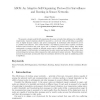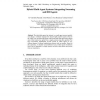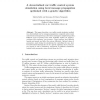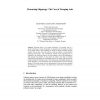98
Voted
ESOA
2006
15 years 4 months ago
2006
There is little or no guidance to systematically design a self-organising emergent solution that achieves the desired macroscopic behaviour. This paper describes decentralised coor...
102
Voted
ESOA
2006
15 years 4 months ago
2006
We present a simple model of self-organization for sensor networks that addresses two conflicting requirements: hazard situations should be reported to a sink node with as little ...
110
click to vote
ESOA
2006
15 years 4 months ago
2006
Holonic Multi-Agent Systems (HMAS) are a convenient way to engineer complex and open systems. In such systems, agents have to be able to self-organize to satisfy their goals. Our w...
97
Voted
ESOA
2006
15 years 4 months ago
2006
Hierarchical clustering is used widely to organize data and search for patterns. Previous algorithms assume that the body of data being clustered is fixed while the algorithm runs...
111
Voted
ESOA
2006
15 years 4 months ago
2006
The individual agents that interact in a multi-agent system typically exist along a continuum ranging from heavyweight cognitive agents (often of the "BDI" type) to light...
116
Voted
ESOA
2006
15 years 4 months ago
2006
This paper describes a car traffic control simulation realised in a decentralised way by message propagations: congested nodes (roads intersections) send speed-up or slow-down mess...
ESOA
2006
15 years 4 months ago
2006
ESOA
2006
15 years 4 months ago
2006
The research reported in this paper is concerned with assessing the usefulness of reinforcment learning (RL) for on-line calibration of parameters in evolutionary algorithms (EA). ...
110
click to vote
ESOA
2006
15 years 4 months ago
2006
Evolutionary algorithms based on "tags" can be adapted to induce cooperation in selfish environments such as peer-to-peer systems. In this approach, nodes periodically co...




